Smith and Wesson 1911 E-Series Stainless .45 ACP 5″ Barrel 8-Rounds Laminate Wood Grip For Sale
$1,386.99
The Smith and Wesson 1911 E-Series Stainless .45 ACP is an expertly crafted firearm that merges the classic 1911 design with modern enhancements, appealing to enthusiasts who seek precision and high performance. Part of Smith & Wesson’s esteemed E-Series, this model is built on the legendary 1911 platform, originally designed by John Moses Browning, and features a durable construction with a stainless steel frame, barrel, and slide, all finished in a sleek satin and matte silver. The pistol is equipped with tritium night sights for improved accuracy in low light, a serrated slide for easy handling, and laminate wood grips that provide comfort and a secure hold for right-handed users. It includes a Picatinny rail for accessory attachment and weighs 41.60 ounces, which aids in stability and recoil reduction. Prioritizing safety, it has a manual thumb and grip safety, operates on a single-action mechanism, and offers a magazine capacity of 8+1 rounds of .45 ACP. This model is tailored for those who value the integration of historical heritage and modern features in a reliable pistol for both field and range use.
What is an E series 1911?
The “E Series” 1911 refers to a line of 1911-style pistols produced by Smith & Wesson. These firearms are based on the classic design of the M1911, a staple in the handgun world, originally designed by John Browning and historically used by the U.S. military. The Smith & Wesson E Series 1911s incorporate modern enhancements while retaining the timeless aesthetics and ergonomics of the traditional 1911.
Key features of the E Series often include improved ergonomics, combat sights, enhanced triggers, precision barrels, and sometimes the use of stainless steel or other high-quality materials. The series is known for its blend of traditional 1911 features with modern advancements, appealing to both collectors and shooters looking for reliability and performance.
What is the weakness of the 1911?
The M1911 pistol, while historically significant and widely used, does have some weaknesses:
1. **Magazine Capacity**: The standard 1911 holds 7-8 rounds in the magazine, which is limited compared to more modern semi-automatic pistols that often carry 15 or more rounds.
2. **Weight and Size**: The 1911 is relatively heavy and large, making it less ideal for concealed carry or for individuals seeking a lighter firearm.
3. **Recoil Management**: Being chambered in .45 ACP, the recoil can be more significant, which might affect accuracy for some shooters compared to pistols chambered in smaller calibers.
4. **Maintenance**: The 1911 requires regular maintenance and cleaning to function reliably. It can be more complex to disassemble and maintain compared to modern pistols.
5. **Price**: Often, particularly well-made 1911 models can be more expensive than other pistols with similar performance.
6. **Ergonomics**: While many appreciate the design, some users might find the grip angle and safety mechanisms less user-friendly compared to newer designs.
These factors, among others, can make the 1911 less appealing for certain applications despite its iconic status.
What is the most rare Smith and Wesson?
One of the rarest Smith & Wesson firearms is the Smith & Wesson Registered Magnum. Introduced in 1935, each gun was custom-ordered and came with a registration certificate, making it highly sought after by collectors due to its limited production and personalized nature.
How much does a Smith and Wesson 1911 E Series weight?
The Smith & Wesson 1911 E Series typically weighs around 41.0 ounces (approximately 2.56 pounds) when unloaded.
What 1911 does the FBI use?
The FBI has used the Springfield Armory 1911, specifically the Springfield Custom Professional Model 1911A1, as part of its inventory for specialized units such as the Hostage Rescue Team (HRT) and SWAT teams. This firearm is valued for its reliability and accuracy.
Why is the 1911 so special?
The 1911 is special for several reasons:
1. **Design and Engineering**: Designed by the legendary firearm designer John Browning, the 1911 features a robust and reliable design that has stood the test of time. Its use of single-action operation and short recoil functionality are notable innovations.
2. **Historical Significance**: Adopted by the U.S. military in 1911, it served as the standard-issue sidearm through both World Wars and the Korean and Vietnam Wars. Its long service history has cemented its place in military and firearm history.
3. **Cultural Impact**: The 1911 has become an icon in popular culture, frequently appearing in films, literature, and video games, contributing to its legendary status.
4. **Performance**: Known for its accuracy, stopping power, and durability, the 1911 uses the .45 ACP cartridge, which provides significant stopping power. Its reliability and ease of maintenance have made it a favorite among enthusiasts and professionals.
5. **Customization**: The design of the 1911 lends itself to customization, allowing users to modify grips, triggers, and sights according to personal preference, which adds to its appeal for collectors and competitive shooters.
These factors combined have contributed to the 1911’s enduring legacy and continued popularity over a century later.
Why do 1911s jam so much?
The 1911 pistol, originally designed by John Browning and adopted by the U.S. military in 1911, is known for its robust design and historical significance. However, several factors can contribute to its tendency to jam:
1. **Tight Tolerances:** Many modern 1911s are built with tighter tolerances for improved accuracy. This can sometimes make them less forgiving with debris or dirt, leading to jams.
2. **Ammunition Sensitivity:** The 1911 was originally designed to work with .45 ACP ball (full metal jacket) ammunition. Using different types or less powerful loads can sometimes cause feeding issues.
3. **Magazine Issues:** The design and condition of the magazine can heavily influence feeding reliability. Worn or poor-quality magazines can cause jams.
4. **Extractor Tuning:** The extractor in a 1911 needs to be properly tuned and maintained. If not, it can lead to failures in feeding or extracting rounds.
5. **Recoil Spring:** Using the wrong recoil spring strength can influence cycling and reliability. A spring that’s too weak or too strong can cause malfunctions.
6. **Maintenance and Cleaning:** A lack of proper maintenance, lubrication, or cleaning can lead to dirt build-up and eventually cause operational issues.
7. **Customization and Aftermarket Parts:** Many 1911s are customized, which can sometimes lead to compatibility or reliability issues if parts are not properly installed or fitted.
By addressing these factors, users can mitigate many potential jamming issues with a 1911.
What not to do with a 1911?
When handling a 1911 pistol, there are several things you should avoid doing to ensure safety and maintain the firearm’s condition:
1. **Ignore Safety Protocols**: Never forget to engage the safety, and always keep your finger off the trigger until you are ready to shoot.
2. **Use Incompatible Ammunition**: Avoid using ammunition not specifically designed for your model of 1911, as using incorrect or reloaded ammunition can cause malfunctions or damage.
3. **Neglect Regular Maintenance**: Failing to regularly clean and lubricate your 1911 can lead to performance issues and increased wear.
4. **Improper Disassembly**: Do not attempt to disassemble your 1911 without proper knowledge or guidance, as incorrect handling can cause damage to the firearm.
5. **Point at Unsafe Targets**: Never point the gun at anything you do not intend to shoot, and always be aware of your target and what is beyond it.
6. **Store Loaded**: Do not store your 1911 loaded, especially if it is not in a secure location inaccessible to unauthorized persons.
7. **Alter Without Expertise**: Avoid making modifications to the gun unless you are experienced or have the assistance of a qualified gunsmith.
By avoiding these actions, you ensure safer handling and longevity of your 1911.
Are 1911 high maintenance?
The maintenance requirements of a 1911 pistol can vary depending on the specific model and usage, but here are some general considerations:
1. **Regular Cleaning**: 1911 pistols typically require frequent and thorough cleaning to ensure optimal performance. They can be more prone to jamming or malfunctioning if not properly maintained.
2. **Proper Lubrication**: These firearms require adequate lubrication to function smoothly. Over time, the moving parts can experience wear and tear without regular oiling.
3. **Parts Inspection**: Regular inspection of parts, such as springs, extractors, and firing pins, is necessary to identify any wear or potential failures, which might require replacement.
4. **Customization and Fitting**: High-end or custom 1911s might need specialist attention for specific tuning or fitting of parts, which can elevate maintenance requirements.
5. **Ammunition Sensitivity**: Some 1911 models can be picky with ammunition, necessitating some trial and error to find brands or types that function reliably.
Overall, while not excessively high-maintenance, 1911 pistols do require consistent care and attention compared to some modern pistols designed with lower maintenance in mind.
What gun did Glock sue Smith &, Wesson over?
Glock sued Smith & Wesson over the Sigma series of pistols. Glock claimed that the design of the Sigma series infringed on Glock’s patents related to their own pistols. The lawsuit was settled, with Smith & Wesson agreeing to make changes and pay an undisclosed amount to Glock.
What’s the most sought after gun?
The most sought-after gun can vary depending on factors such as geographic location, purpose (e.g., self-defense, hunting, sport shooting), and current market trends. Generally, popular models often include the Glock 19, AR-15 rifles, and Sig Sauer P320 pistols. The popularity of specific guns can change over time due to changes in regulations, new releases, and shifts in consumer preferences. For the most accurate and current information, checking with local gun retailers or industry reports would be helpful.
What Smith and Wesson did Dirty Harry use?
Dirty Harry, played by Clint Eastwood, used a Smith & Wesson Model 29 revolver in the 1971 film “Dirty Harry.” The Model 29 is chambered for the powerful .44 Magnum cartridge.
What is the difference between Colt 1911 models?
The Colt 1911 models differ in several ways, including features, size, materials, and intended use. Here are some key distinctions:
1. **Materials and Finish**: Different models may feature various materials such as stainless steel, carbon steel, or aluminum. They also come in finishes like blued, satin, or coated.
2. **Caliber**: While most Colt 1911s are chambered in .45 ACP, some models are available in other calibers like 9mm or .38 Super.
3. **Size**: Models vary in barrel lengths and overall size, from the full-size Government model to the more compact Commander and Officer models.
4. **Features**: Some models come with additional features like tactical rails, night sights, or extended controls, catering to different uses such as concealed carry or competition.
5. **Edition and Style**: Colt regularly releases limited editions or custom models with unique engravings, grips, or accessories.
6. **Intended Use**: Variations are designed for specific purposes, including target shooting, tactical use, or personal defense.
These differences allow consumers to choose a model that best fits their needs and preferences.
What 1911 do special forces use?
Many special forces units have used various iterations of the 1911 pistol due to its reliability and stopping power. One of the more commonly used models is the Colt M1911 or its modernized version, the Colt M45A1. Another variant is the Kimber Warrior, which has been used by some special operations units. These pistols are favored for their performance in demanding conditions.
How many types of 1911 are there?
The 1911 is a popular type of semi-automatic pistol originally designed by John Browning and adopted by the U.S. military as the M1911 in the early 20th century. Over the years, many different manufacturers have produced their own versions or variants of the 1911, leading to a vast array of models. These can differ in terms of size, materials, caliber, and features.
Given the widespread production and variation, it is difficult to provide an exact number of 1911 types, as new models and customizations continue to be developed. However, hundreds of 1911 models and variants from numerous manufacturers exist on the market today. Major companies such as Colt, Kimber, Springfield Armory, Smith & Wesson, and many others have created their own versions, adding to the diversity available.
| Frame Material | Stainless Steel |
|---|---|
| Model | 1911 |
| Action | SAO |
| Frame Finish | Matte Silver |
| Overall Length | 8.70" |
| Hand Orientation | Right |
| Slide Finish | Satin Stainless |
| Slide Material | Stainless Steel |
| Grips | Laminate Wood |
| Safety | Manual Thumb, Grip |
Be the first to review “Smith and Wesson 1911 E-Series Stainless .45 ACP 5″ Barrel 8-Rounds Laminate Wood Grip” Cancel reply
Related products
s&w 1911 e series
Smith and Wesson 1911 E-Series “Viking” Gold Inlay On Stainless .45 ACP 5″ 8Rds GrabAGun Exclusive
s&w 1911 e series
Smith and Wesson 1911 Performance Center Pro .45 ACP 3″ Barrel 7-Rounds
s&w 1911 e series
Smith and Wesson 1911 E-Series Stainless .45 ACP 4.25″ Barrel 8-Rounds
s&w 1911 e series
Smith and Wesson 1911 E-Series Stainless .45 ACP 5″ Barrel 8-Rounds
s&w 1911 e series
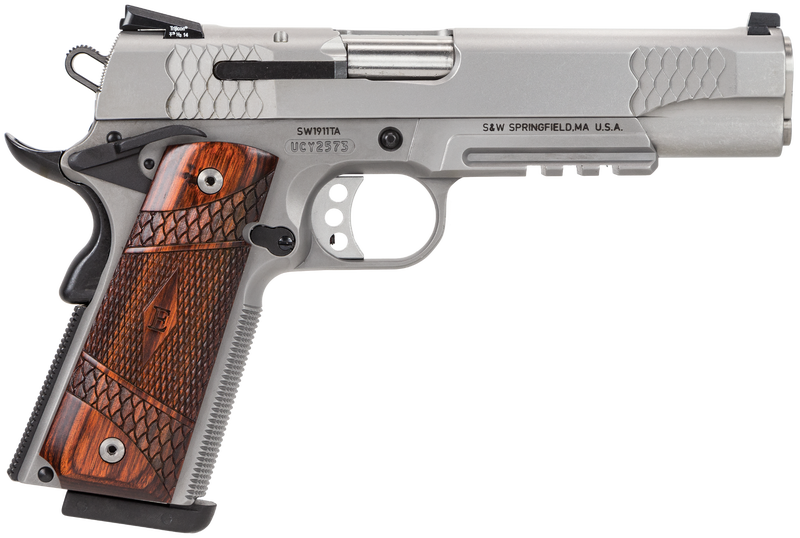
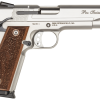

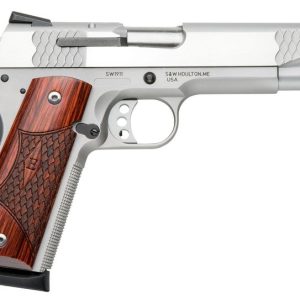
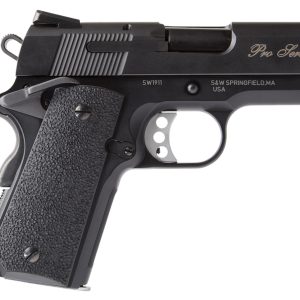

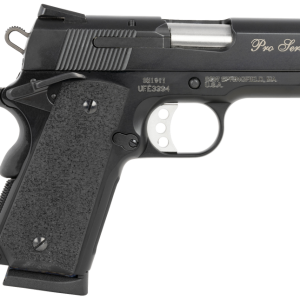


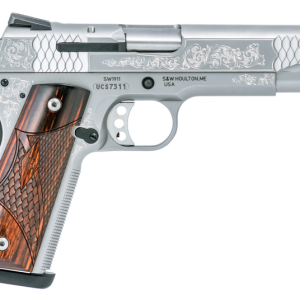

Reviews
There are no reviews yet.